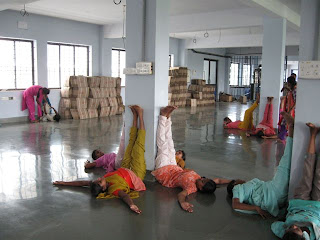Hello dear friends and family. We are starting our second week in Rajpur a little village in the foothills of the Himalayas in Northern India. The weather is perfect, air is clean, gardens are lush and the yoga instruction is excellent. We are also learning a lot about Ayurveda and are living and eating a very clean life. Life is good here and we are thoroughly enjoying our morning, afternoon and evening walks, lectures, reading and oil therapies.
There are 200 Tibetan families living in this village and they bring wonderful smiles and greetings to the walks. Below are some pictures of the streets of Rajpur, many little shops line the streets selling fruits, veggies, clothes, hardware. The streets are narrow and hilly, but not too crowded.
There is a photo of the studio YogGanga and a male monkey walking along a street ledge. As you can see he has a bright red bum and one of them has thus far stolen a full bag of bananas and another from Bill’s bag as he was walking.
There are some photos of school children on their way to school dressed in their uniforms, and a sweet dog that comes to visit us frequently at the coffee shop where we go after class.
A young lady is stamping fabric to be sold at the women’s handicraft shop.
And today we had lunch at the yoga center with the Ayurvedic doctor and our class. There we met a good friend of our friends in Madurai. J. Nath, one of his paintings is below. We’ve seen his work in a number of homes in Southern India. What a small world!
We leave for Delhi and then home 2 weeks from tomorrow and arrive the same day we leave due to crossing the dateline. We send you all our love. Do drop a line and let us know what is happening back home. We miss you all and look forward to seeing you soon. With love , gratitude and blessings, Susy and Bill



















































